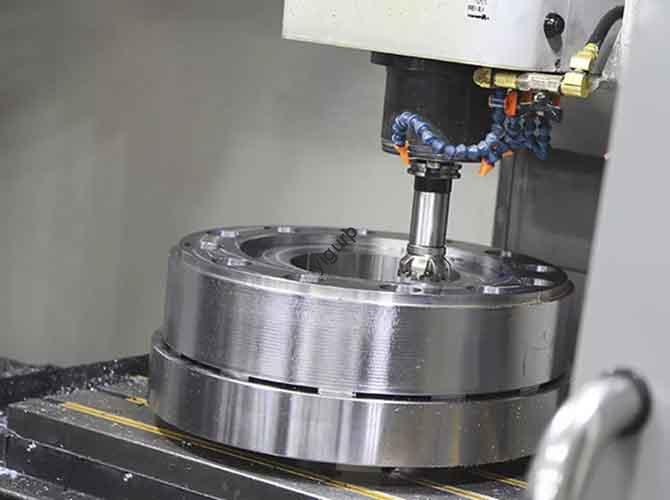In produzione di precisione, achieving ultra-high accuracy and smooth surface finishes is non-negotiable—and CNC grinding stands as the go-to solution. But what exactly is CNC grinding? How does it differ from traditional grinding? And which industries benefit most from it? This guide answers these questions, breaks down the process, and helps you leverage CNC grinding for your production goals.
1. What Is CNC Grinding? Definizione principale & Componenti chiave
CNC grinding is a computer-controlled machining process that uses rotating grinding wheels to remove material from workpieces, delivering exceptional precision. A differenza della macinazione manuale (which relies on human skill), CNC grinding uses pre-programmed instructions to control every parameter—from wheel speed to tool path—ensuring consistency across every part.
Essential Components of a CNC Grinding Machine
| Componente | Funzione |
| CNC Control System | The “brain” – interprets G-code to manage wheel movement, velocità, e pressione. |
| Ruota macinata | The cutting tool – made of abrasive materials (PER ESEMPIO., ossido di alluminio) tailored to workpiece material. |
| Worktable | Holds the workpiece – moves along X/Y/Z axes for precise positioning. |
| Mandrino | Drives the grinding wheel – operates at speeds up to 15,000 RPM for fine grinding. |
| Coolant System | Reduces heat and friction – prevents workpiece warping and wheel wear. |
| Positioning Sensors | Monitors workpiece/wheel alignment – ensures accuracy within ±0.0005mm. |
2. Il processo di macinazione CNC: Breakdown passo-passo
CNC grinding follows a linear, repeatable workflow to guarantee quality. Here’s how it works from start to finish:
- Programmazione & Preparazione
Primo, utilizzo CAD/CAM software (PER ESEMPIO., Solidworks, Mastercam) to design the workpiece’s 3D model. The software then generates a CNC program (G-codice) with exact parameters: grinding depth (often 0.001-0.01mm), wheel speed, and tool path. Import the program into the CNC grinder, then install the correct grinding wheel (PER ESEMPIO., diamond wheels for hard metals like steel) and adjust machine settings (PER ESEMPIO., coolant flow rate).
- Serraggio & Posizionamento
Secure the workpiece to the worktable using fixtures (PER ESEMPIO., vices, magnetic chucks). Positioning devices (like laser sensors) align the workpiece with the grinding wheel—this step is critical: even a 0.001mm misalignment can ruin a precision part.
- Automatic Grinding
Start the machine: the CNC system executes the program, moving the worktable and spinning the wheel to remove material. During processing, sensors monitor temperature and wheel wear in real time. If the wheel dulls, the system adjusts pressure or speed to maintain quality.
- Post-elaborazione & Ispezione di qualità
Dopo aver macinato, deburr the workpiece (to remove sharp edges) and clean it with industrial solvents. Then inspect it using tools like:
- Micrometri: Check dimensional accuracy (PER ESEMPIO., a shaft’s diameter must be 10mm ±0.0005mm).
- Surface Roughness Testers: Verify finish (CNC grinding often achieves Ra 0.02-0.2μm—smoother than a polished mirror).
Esempio: An aerospace manufacturer uses CNC grinding to finish titanium turbine blades. The process ensures each blade’s edge is precise to 0.0003mm—critical for withstanding 1,000°C engine temperatures.
3. CNC Grinding vs. Traditional Grinding: Un chiaro confronto
Why choose CNC grinding over manual methods? The table below highlights the key differences:
| Fattore | Macinatura CNC | Traditional Manual Grinding |
| Precisione | ±0.0005mm – ideal for precision parts | ±0.01mm – inconsistent for tight tolerances |
| Efficienza | 2-3x faster – can run 24/7 unattended | Slow – relies on operator speed/skill |
| Coerenza | 99.9% part uniformity across batches | Varies by operator – high defect risk |
| Flessibilità | Quick program changes for new parts (1-2 ore) | Requires retooling (4-8 ore) |
| Skill Requirement | Basic training (1-2 settimane) | Expert skill (2-3 anni di esperienza) |
4. Key Technical Advantages of CNC Grinding
CNC grinding solves common manufacturing pain points with four core benefits:
1. Precisione senza pari
- Come funziona: The CNC system eliminates human error—no more “operator fatigue” leading to miscuts. Per esempio, a medical device maker uses CNC grinding to create 0.5mm-diameter surgical needles, ensuring each needle is identical.
2. Alta efficienza
- Causal chain: Automated operation → 24/7 production → shorter lead times. A automotive parts factory reduced production time for brake rotors by 60% after switching to CNC grinding.
3. Strong Flexibility
- Scenario: A mold shop needs to switch from making plastic bottle molds to smartphone case molds. With CNC grinding, they simply upload a new program—no need to rebuild the entire setup.
4. Qualità superficiale superiore
- Analogia: Traditional grinding is like sanding wood with a rough paper; CNC grinding is like using fine sandpaper followed by polish. It delivers surfaces so smooth they require no additional finishing—saving time and cost.
5. Yigu Technology’s Perspective on CNC Grinding
Alla tecnologia Yigu, vediamo CNC grinding as the backbone of precision manufacturing. For clients in aerospace, medico, o industrie automobilistiche, we recommend customizing CNC grinding solutions—e.g., ruote di diamanti per metalli duri, or CBN wheels for steel. We also emphasize preventive maintenance: regular wheel calibration and coolant replacement can extend machine life by 30%. Our team provides on-site training to help operators optimize programs, ensuring clients get the most out of their CNC grinders.
Domande frequenti
- Q: What materials can be processed with CNC grinding?
UN: Almost all hard materials—including steel, titanio, ceramica, and even superalloys (used in jet engines). Materiali morbidi (PER ESEMPIO., alluminio) are less common, as they can clog the grinding wheel.
- Q: How often do I need to replace the grinding wheel in a CNC grinder?
UN: It depends on usage and material. Per parti in acciaio, a wheel lasts 200-300 ore; for harder ceramics, it may last 50-100 ore. The CNC system often alerts you when the wheel is dull.
- Q: Can CNC grinding handle large workpieces (PER ESEMPIO., 2-meter-long shafts)?
UN: SÌ. Industrial CNC grinders with extended worktables can process parts up to 5 metri di lunghezza. Just ensure the machine’s spindle power (15-30KW) is sufficient for heavy grinding.
